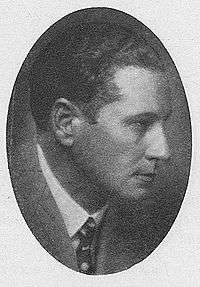Urho Somersalmi
Urho Somersalmi (formerly Sundell, 23 September 1888, Helsinki – 12 April 1962) was a Finnish actor. He worked in the Finnish National Theatre from 1908 to 1958. Somersalmi was often seen in roles of masculine heroes or first-time lovers. His physical appearance was very suitable for such roles; and in the beginning of his career, he was often criticized for superficiality. Somersalmi was awarded the Pro Finlandia medal in 1948. He married actress Aili Somersalmi in 1912.[1]

Somersalmi was involved in the Finnish film industry from the beginning. In 1913, he had his first small film role in a Teuvo Puro film Sylvi, the first Finnish drama film. His final appearance was in the Finnish-Soviet co-production film Sampo (1959) in which he played the role of Väinämöinen.[2]
In April 1962, Somersalmi killed his wife with an axe he had received as a gift from Finnish Actors' Union. Then he hanged himself on the ceiling lamp hook.[3] It has been claimed that Urho Somersalmi's ghost haunts the Finnish National Theatre along with two other ghosts.[4]
Selected filmography
- Sylvi (1913)
- Johan (1921)
- Tukkijoella (1928)
- Charlotte Löwensköld (1930)
- Pohjalaisia (1936)
- Jääkärin morsian (1938)
- Vaivaisukon morsian (1944)
- Pimeänpirtin hävitys (1947)
- Risti ja liekki (1957)
- Sampo (1959)
References
- Koskimies, Rafael (1953). Suomen Kansallisteatteri 1902/1917. Kustannusosakeyhtiö Otava.
- "ELONET – Urho Somersalmi". KAVA. Retrieved 29 January 2013.
- Leppänen, Marko. "Nainen joka tuntee kummitukset – HS.fi". Helsingin Sanomat. Retrieved 29 January 2013.
- Tiensuu, Maaret. "Urho vaeltaa teatterissa kirves kädessään – lähde kierrokselle Helsingin kuuluisiin kummitustaloihin!". MTV Lifestyle. Retrieved 22 December 2015.